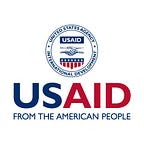Rebuilding Lives in South Sudan
Helping communities that escaped war recover as they return home
In Bor County, South Sudan, conflict erupted in 2013 and forced families to flee their homes and farms. Now, as families begin to return, USAID is helping them get back on their feet.
USAID, in partnership with Catholic Relief Services, is working with families in Jonglei State to build resilience to conflict-driven crises, as well as drought and flooding. By promoting self-reliance within households and communities, the program also helps to reduce dependence on relief assistance.
Read four stories of how USAID is helping families build resilience and find ways to earn income and feed their families.
1) Growing Vegetables & Pooling Savings
Atoch Mawut Lat, 36, and her family lived in a camp for internally displaced persons for more than two years before returning home, only to find it had been destroyed.
“Two huts had been burned down, and two had collapsed due to lack of upkeep during the rainy seasons,” said Atoch, who has six children.
Atoch joined a group supported by USAID that taught her how to grow vegetables, which she sells in the market.
“Now, I get food from farming,” she said. “I am able to pay school fees. I can also buy plastic sheeting to help in the building of my house.”
She also learned to pool savings with her community. “My infant has to be taken to the hospital sometimes because the child gets sick easily,” Atoch says. “But now I can use the money from the rotational savings group to pay for health services and medication.”
2) Raising Goats
At a livestock fair, Mary Nyanjok Puoch, a 35-year-old widow with six children, used a voucher from USAID to buy three goats.
USAID provided vouchers to some of the most vulnerable families in the area and connected them with local livestock vendors with healthy goats for sale.
The goats provide Mary’s family with milk to improve nutrition and generate income, and Mary can grow the size of her goat herd or sell the goats if she needs cash urgently.
“I am very happy because after paying back the loan for the three goats, I was left with a good number of goats and was able to trade some,” said Mary.
“For my children, I envision they will get an education because of the goats that I have. The goats are my bank.” — Mary
In a second round of distribution, instead of repaying the loan from the program, she gave the goats to the next recipient chosen by the program, so the program does not need to provide vouchers to other beneficiaries to buy goats. Anyieth Kuol Jok, 37, received her goats as part of that second round.
3) Participating in Food-for-Assets Opportunities
Pastoralist James Jongkuch Nyang, 55, lives in Ruar Leek Village, which suffers from a harsh drought every dry season. He took part in USAID’s food-for-assets activity, joining his community in digging a pond that would provide enough water to sustain the village through the dry months, and received food in exchange for the labor.
“We’re digging out a pond so that our cattle can get water nearby. Then the cattle will not get lost and I will not have to go around looking for them all the time,” James says, with a laugh.
The community can also use the water for other household needs, such as for gardening and chores, and it will help with irrigation and drainage.
4) Strengthening Education
Finally, rebuilding lives as communities return home goes beyond training in agriculture and caring for livestock. Achol Mayen, 35, never had the chance to go to school, but through USAID, she is learning the alphabet for the first time. The classes she takes teach basic literacy and math.
“When I [buy medicine], I want to be able to read the prescriptions, the expiration date and the instructions about how my medicine should be taken,” said Achol.
Conflict has decreased in South Sudan since a revitalized peace agreement was signed in September 2018. However, needs remain extremely high. More than 4 million people are displaced (1.8 million internally in South Sudan and 2.3 million refugees in neighboring countries), and nearly 7 million people (61 percent of the population) are projected to need lifesaving food assistance this year.
The United States is the single largest provider of humanitarian assistance to South Sudan, having provided more than $4 billion since the start of the conflict in December 2013. More than 950,000 metric tons of food assistance have reached 1.5 million South Sudanese people every month.
For more information:
- Read more about USAID’s work in South Sudan
- Check out the USAID Office of Food for Peace fact sheet on South Sudan
